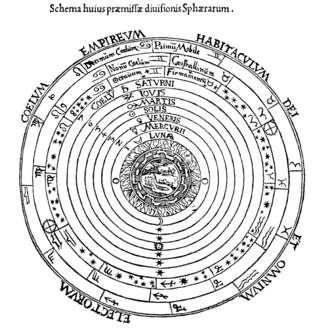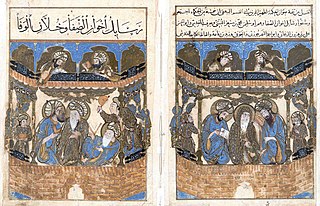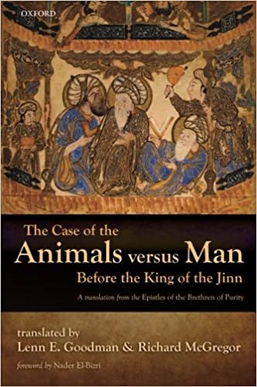Related Research Articles

Islamic philosophy is philosophy that emerges from the Islamic tradition. Two terms traditionally used in the Islamic world are sometimes translated as philosophy—falsafa, which refers to philosophy as well as logic, mathematics, and physics; and Kalam, which refers to a rationalist form of Scholastic Islamic theology which includes the schools of Maturidiyah, Ashaira and Mu'tazila.
Early Islamic philosophy or classical Islamic philosophy is a period of intense philosophical development beginning in the 2nd century AH of the Islamic calendar and lasting until the 6th century AH. The period is known as the Islamic Golden Age, and the achievements of this period had a crucial influence in the development of modern philosophy and science. For Renaissance Europe, "Muslim maritime, agricultural, and technological innovations, as well as much East Asian technology via the Muslim world, made their way to western Europe in one of the largest technology transfers in world history." This period starts with al-Kindi in the 9th century and ends with Averroes at the end of 12th century. The death of Averroes effectively marks the end of a particular discipline of Islamic philosophy usually called the Peripatetic Arabic School, and philosophical activity declined significantly in Western Islamic countries, namely in Islamic Spain and North Africa, though it persisted for much longer in the Eastern countries, in particular Persia and India where several schools of philosophy continued to flourish: Avicennism, Illuminationist philosophy, Mystical philosophy, and Transcendent theosophy.

The microcosm–macrocosm analogy refers to a historical view which posited a structural similarity between the human being and the cosmos as a whole. Given this fundamental analogy, truths about the nature of the cosmos as a whole may be inferred from truths about human nature, and vice versa.

Abū Bakr Muḥammad ibn Yaḥyà ibn aṣ-Ṣā’igh at-Tūjībī ibn Bājja, best known by his Latinised name Avempace, was an Andalusi polymath, whose writings include works regarding astronomy, physics, and music, as well as philosophy, medicine, botany, and poetry.
Jacob ben Machir ibn Tibbon, of the Ibn Tibbon family, also known as Prophatius, was a Jewish astronomer; born, probably at Marseilles, about 1236; died at Montpellier about 1304. He was a grandson of Samuel ben Judah ibn Tibbon. His Provençal name was Don Profiat Tibbon; the Latin writers called him Profatius Judæus. Jacob occupies a considerable place in the history of astronomy in the Middle Ages. His works, translated into Latin, were quoted by Copernicus, Reinhold, and Clavius. He was also highly reputed as a physician, and, according to Jean Astruc, Ibn Tibbon was regent of the faculty of medicine of Montpellier.
This article covers the conversations between Islamic philosophy and Jewish philosophy, and mutual influence on each other in response to questions and challenges brought into wide circulation through Aristotelianism, Neo-platonism, and the Kalam, focusing especially on the period from 800–1400 CE.
Early Islamic law placed importance on formulating standards of argument, which gave rise to a "novel approach to logic" in Kalam . However, with the rise of the Mu'tazili philosophers, who highly valued Aristotle's Organon, this approach was displaced by the older ideas from Hellenistic philosophy. The works of al-Farabi, Avicenna, al-Ghazali and other Muslim logicians who often criticized and corrected Aristotelian logic and introduced their own forms of logic, also played a central role in the subsequent development of European logic during the Renaissance.
Ibn Miskawayh, full name Abū ʿAlī Aḥmad ibn Muḥammad ibn Yaʿqūb Miskawayh al-Rāzī was a Persian chancery official of the Buyid era, and philosopher and historian from Parandak, Iran. As a Neoplatonist, his influence on Islamic philosophy is primarily in the area of ethics. He was the author of the first major Islamic work on philosophical ethics entitled the Refinement of Character, focusing on practical ethics, conduct, and the refinement of character. He separated personal ethics from the public realm, and contrasted the liberating nature of reason with the deception and temptation of nature. Miskawayh was a prominent figure in the intellectual and cultural life of his time.
Abu Ya'qub Ishaq ibn Ahmad al-Sijistani or al-Sijzi (السجزي), also known as Bandaneh, was a 10th-century Persian Ismaili missionary active in the northern and eastern Iranian lands. His life is obscure, but he was a prolific writer, who played a crucial role in the infusion of Neoplatonic ideas into Isma'ili theology.

Nous, from Greek: νοῦς, is a concept from classical philosophy, sometimes equated to intellect or intelligence, for the faculty of the human mind necessary for understanding what is true or real.
Risala or risalah or risalat, also spelled resala/resalah/resalat, plural rasa'il, is an Arabic word (رِسالة) meaning "letter", "epistle", "treatise", or "message". It may refer to:

The Brethren of Purity were a secret society of Muslim philosophers in Basra, Iraq, in the 9th or 10th century CE.

The Encyclopedia of the Brethren of Purity also variously known as the Epistles of the Brethren of Sincerity, Epistles of the Brethren of Purity and Epistles of the Brethren of Purity and Loyal Friends is an Islamic encyclopedia in 52 treatises (rasā'il) written by the mysterious Brethren of Purity of Basra, Iraq sometime in the second half of the 10th century CE. It had a great influence on later intellectual leading lights of the Muslim world, such as Ibn Arabi, and was transmitted as far abroad within the Muslim world as al-Andalus.
In medieval philosophy, the active intellect is the formal (morphe) aspect of the intellect (nous), according to the Aristotelian theory of hylomorphism. The nature of the active intellect was a major theme of late classical and medieval philosophy. Various thinkers sought to reconcile their commitment to Aristotle's account of the body and soul to their own theological commitments. At stake in particular was in what way Aristotle's account of an incorporeal soul might contribute to understanding of deity and creation.
Abu al-Husayn Ahmad ibn Abd Allah ibn Muhammad ibn Isma'il, commonly known as Muhammad al-Taqi, was a descendant of the Islamic prophet Muhammad and the ninth of the Isma'ili Imams, succeeding his father, Ahmad al-Wafi. Like his father, he lived primarily in Salamiyah, and Abd Allah ibn Maymun al-Qaddah, the chief missionary, continued to serve as the hijab for him. Known by the title Ṣāḥib al-Rasāʾil, al-Taqi is said to have prepared with his followers an encyclopedic text called the Encyclopedia of the Brethren of Purity. He died in 840 in Salamiyah and was succeeded by his son al-Husayn.
Abu ʿAlī al-Ḥusayn ibn Aḥmad ibn ʿAbd Allāh ibn Muḥammad ibn Ismāʿīl, also known as al-Zakī, al-Raḍī and al-Muqtadā al-Hādī, was a descendant of the Islamic prophet Muhammad and the tenth of the Isma'ili Imams, succeeding his father, Muhammad al-Taqi. Before his death in 881, he entrusted the care of his son and successor, Abd Allah al-Mahdi who was then around 8 years old to his full brother, Sa'id al-Khayr, also known as Abu'l-Shalaghlagh.
Nader El-Bizri served as the Dean of the College of Arts, Humanities, and Social Sciences at the University of Sharjah. He was before that a tenured longstanding full Professor of philosophy and civilization studies at the American University of Beirut, where he also acted as an Associate Dean of the Faculty of Arts and Sciences, and as the Director of the General Education program. El-Bizri specializes in phenomenology, Islamic science and philosophy, and architectural theory. He is the author or editor of several books, including The Phenomenological Quest between Avicenna and Heidegger (2000).
Abū aṣ-Ṣalt Umayya ibn ʿAbd al-ʿAzīz ibn Abī aṣ-Ṣalt ad-Dānī al-Andalusī, known in Latin as Albuzale, was an Andalusian-Arab polymath who wrote about pharmacology, geometry, Aristotelian physics, and astronomy. His works on astronomical instruments were read both in the Islamic world and Europe. He also occasionally traveled to Palermo and worked in the court of Roger I of Sicily as a visiting physician. He became well known in Europe through translations of his works made in the Iberian Peninsula and in southern France. He is also credited with introducing Andalusi music to Tunis, which later led to the development of the Tunisian ma'luf.
Afḑal al-Dīn Maraqī Kāshānī, also known as Baba Afzal, was a Persian poet and philosopher. Several dates have been suggested for his death, with the best estimate being around 1213/1214.

Fī aṣnāf al-ḥayawānāt wa-ʿajāʾib hayākilihā wa-gharāʾib aḥwālihā, known in English as The Case of the Animals versus Man Before the King of the Jinn, is an epistle written by the Brethren of Purity in the 960s and first published as Epistle 22 in the Encyclopedia of the Brethren of Purity. The longest Encyclopedia entry, The Case of the Animals versus Man revolves around a group of talking animals who testify against humans in a session chaired by the ruler of the jinn. It has been favourably received by literary critics and translated into several languages.
References
- ↑ Tibawi, A. L. (1955). "Ikhwan as-Safa and their Rasa'il: A Critical Review of a Century and a Half of Research". The Islamic Quarterly. 2. ISSN 0021-1842.
- ↑ "However, differences exist between the races and nations of the earth. According to the theory of racial differences, which we also find in the same context in al-Kindi: the particularizing and characterizing signs that distinguish nations and races are not the results of inheritance, but are caused by the place the various groups inhabit, and its climate." page 8 of Shiloah 1978
- ↑ "Notices of some copies of the Arabic work entitled "Rasàyil Ikhwàm al-cafâ"", written by Aloys Sprenger, originally published by the Journal of the Asiatic Society of Bengal (in Calcutta) in 1848
- 1 2 3 "The Institute of Ismaili Studies: The Classification of the Sciences according to the Rasa'il Ikhwan al-Safa'". December 16, 2003. Archived from the original on 2003-12-16.
- ↑ "When I originally undertook to prepare this text for publication, it very soon became clear to me that this treatise in its range, construction, purpose and richness of thematic material was unique of its kind, both in the Arabic musical literature that preceded and followed it and, perhaps, in the whole of medieval musical literature." page 5 of Shiloah 1978.
- ↑ "If one establishes the measure of time by the regular, harmonious and proportionate succession of motions and silences, the notes resulting will be comparable to the notes produced by the movements of the sphere and the heavenly bodies and in concordance with them. Thus doing, the individual soul that inhabits the world of generation and corruption, will recall the beatitude of the world of the spheres and the felicity of the souls who are there above. It will know and will acquire the conviction that the souls of the celestial world enjoy the best conditions, the sweetest delights and the most lasting felicity, for the notes produced by the movements of the spheres are purer, their melodies sweeter; for these celestial bodies are of a better constitution, of a more beautiful form, of a purer substance, their movements are better ordered and their concordance is more harmonious. When the individual soul that inhabits the world of generation and corruption will have acquired a knowledge of the states of the celestial world, will have had faith in the truth of what we have described, it will manifest an ardent desire to mount upwards and to join there the souls of its own kind, delivered from nations that disappeared in earlier times." page 35 of Shiloah, 1978.
- ↑ "This is the art of harmony (tayif) which can be defined in terms of proportions. Our intention in this Epistle is not therefore the teaching of the practice of music (ghinī); nor of the instrument art (sinālat al-malāhī), although the study of this aspect is indispensable, but our purpose is to make known the science of proportions and the modality of harmony, the knowledge of which presides at mastery in all the arts." page 12 of Shiloah 1978
- 1 2 3 4 5 6 7 8 9 10 11 12 13 pg. ix of Reijn 1995
- 1 2 3 pg 198-199, Lane-Poole 1883
- 1 2 pg 199, Lane-Poole 1883
- ↑ "Out of His infinite grace He chose a few of his servants and permitted them to draw near to Him, and he revealed some of His hidden secrets to them. They were then sent to summon all men to repent and disclose to the rest of Mankind some of those mysteries, so that they might awaken from their Slumber of Ignorance and live the life of the wise and the blessed, and reach the perfection of Paradise and eternal life." page 11 of Reijn 1995
- ↑ "There are only to ways to get there: having a pure Soul and keeping to the Straight Path. By its very nature Man's Soul is always pure. The human body consists of flesh and blood, bones, veins, sinews, skin and the like; dark and heavy substances originating from the earth and subject to change and decay." page 11 of Reijn 1995
- ↑ "Being 'pure consciousness', the soul directly beholds spiritual realities, even though they are invisible to the human eye, but it beholds the physical world only through the sense. However if the Soul has sunken into a state of ignorance....it will be unable to see God and will be hindered from attaining the blessings of Paradise." page 11 of Reijn 1995
- ↑ "However, some people know and believe that the Revelation is true, others accept it on its own authority without questioning it; others yet again shun theological problems and are reluctant to even discuss them... The souls of all these people have fallen into a slumber of ignorance; only a good and compassionate friend can awaken them", page 14-15. "Only when their Souls have been cleansed and their understanding purified, and when their mental faculties have grown stronger, will the full answer to these questions be revealed to them..." pg 15. "He made man the measure of His creation. Each of us will be his own set of scales, weighing out his own reward or punishment on the Day of Judgement. Man is a microcosm which reflects all creation." pg 16 of Reijn 1995
- ↑ Although the Brethren's beliefs on Jesus sometimes differed from the New Testament's version, they conform to the Qur'anic account, of course. Take pg 29: "In the morning Jesus left his disciples and later appeared among the people, preaching and exhorting them. He was then arrested and taken to the King of the Jews who ordered his crucifixion. But what they crucified was his Humanity." Reijn 1995
- ↑ pg 35: "Know, Brother, that we Brethren should meet one another from time to time at gatherings that exclude outsiders, to discuss our esoteric sciences and to meditate on their secret knowledge...Our Brethren should not scorn any science or book of wisdom, neither should we stick to one "madhhab" in particular. Our "madhhab" comprises all "madhhabs" and all sciences." Reijn 1995
- ↑ pg 37: "We Brethren assist one another against our common foes. Each of us in form support for the others in calamities and misfortune, a protective shield in happiness and adversity, a well-kept treasure for the hour of need, a quiet shelter in distress, a vital bond for those seeking a friend to intercede on their behalf with God, and an inaccessible fortress in which one takes refuge in times of war." Reijn 1995
- Shiloah, Amnon (1978). "The Epistle on music of the Ikhwan Al-Safa" (Document). Tel-Aviv University.
- Lane-Poole, Stanley (1883). Studies in a Mosque (1st ed.). Khayat Book & Publishing Company S.A.L. Retrieved 2007-04-28.
- Van Reijn, Eric (1995). The Epistles of the Sincere Brethren: an annotated translation of Epistles 43-47 (1st ed.). Minerva Press. ISBN 1-85863-418-0.